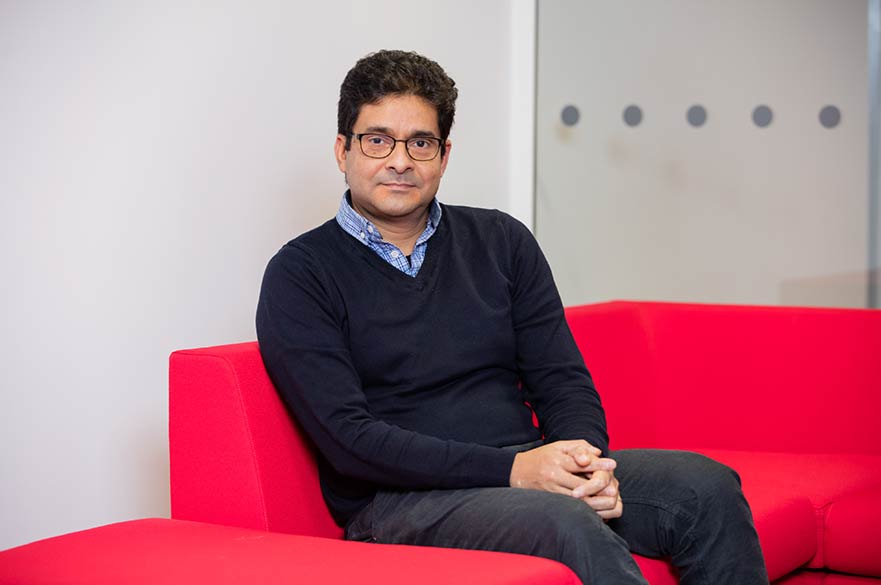Role
Suvo Mitra is a Professor in the Division of Psychology where he teaches biological psychology to undergraduates and conducts research on movement coordination and its interactions with psychological processes such as attention, memory, and imagery. His work also spans motor development and the impact of ageing.
Career overview
Prior to joining NTU in 2014, Professor Mitra worked at the University of Warwick (1998-2014) and Haskins Laboratories, New Haven, CT, USA (1993 - 1998).
Research areas
Professor Mitra's research is on the coordination of movement and its interactions with concurrent mental tasks involving attention, memory and imagery processes. He has worked on dynamical systems theories and analysis techniques for understanding how rhythmic movements are assembled and sustained. He has also studied the control of body posture and the effects of cognitive load on the body's balance and stability. Mental tasks and balance functions interact more strongly in old age, with implications for falling or withdrawal from active living. Thus, ageing is a key area of current interest in this work. Another recent strand of work concerns the other end of the lifespan, where deficits in motor development can have wide-ranging impact on a variety of cognitive and social outcomes in childhood. This work uses population-based longitudinal datasets.
External activity
Professor Mitra serves on the editorial board of the Journal of Experimental Psychology: Human Perception and Performance and Human Movement Science, and has served as an ad hoc reviewer for a range of psychology, neuroscience and medical journals. He is a member of the ESRC Peer Review College (2010-present), and reviews grant applications for BBSRC, MRC and the National Science Foundation (USA), and text publications for Sage and Prentice Hall, among other publishers. He has also served as external examiner at postgraduate level in the UK and overseas, and developed innovative NHS-based postgraduate training opportunities for aspiring clinical psychologists.
Sponsors and collaborators
Professor Mitra's research has been supported by the Royal Society, ESRC, Advantage West Midlands, and Mercia Technology Seed Fund.
Publications
Boulton, H., & Mitra, S. (2013). Body posture modulates imagined arm movements and responds to them. Journal of Neurophysiology, 110, 2617-2626.
Mitra, S., Knight, A., & Munn, A. (2013). Divergent effects of cognitive load on quiet stance and task-linked postural coordination. Journal of Experimental Psychology: Human Perception and Performance, 39, 323-328.
Riley, M.A., Mitra, S., Saunders, N., Kiefer, A.W., & Wallot, S. (2012). The interplay between posture control and memory for spatial locations. Experimental Brain Research, 217, 43-52.
Chen, Yung-Nien, & Mitra, S. (2009). Distinctions between spatial and verbal working memory: A study using event-related potentials. Chang Gung Medical Journal, 32, 380-9.
Chen, Yung-Nien, & Mitra, S. (2009). The spatial-verbal difference in the N-back task: An ERP study. Acta Neurologica Taiwanica, 18, 170-179.
Fraizer, E.V., & Mitra, S. (2008). Postural costs of performing cognitive tasks in non-coincident reference frames. Experimental Brain Research, 185, 429-441.
Fraizer, E.V., & Mitra, S. (2008). Methodological and interpretive issues in posture-cognition dual-tasking in upright stance. Gait and Posture, 27, 271-279.
Chen, Y-N., Mitra, S., & Schlaghecken, F. (2008). Sub-processes of working memory in the N-back task: An investigation using ERPs. Clinical Neurophysiology, 119, 1546-1559.
Chen, Y-N., Mitra, S., & Schlaghecken, F. (2007). Interference from the irrelevant domain in N-back tasks: An ERP study. Acta Neurologica Taiwanica, 16, 125-135.
Mitra, S., Bhalerao, A., Summers, P. & Williams, S.C.R. (2005). Cortical organization of sensory corrections in visuomotor skill acquisition. Neuroscience Letters, 382, 76-81.
Mitra, S., and Turvey, M.T. (2004). A rotation invariant in 3-D reaching. Journal of Experimental Psychology: Human Perception and Performance, 30, 163-179.
Mitra, S. (2004). Adaptive utilization of optical variables during postural and suprapostural dual-task performance. Journal of Experimental Psychology: Human Perception and Performance, 30, 28-38.
Mitra, S. & Fraizer, E.V. (2004). Effects of explicit sway-minimization on postural-suprapostural dual-task performance. Human Movement Science, 23, 1-20.
Mitra, S. (2003). Postural costs of suprapostural task load. Human Movement Science, 22, 253-270.
Goodman, L., Riley, M.A., Mitra, S., & Turvey, M.T. (2000). Advantages of rhythmic movements at resonance: Minimal active degrees of freedom, minimal noise, and maximal predictability. Journal of Motor Behavior, 32, 3-8.
Saltzman, E., Lofqvist, A., & Mitra, S. (2000). ‘Glue’ and ‘clocks’: Intergestural cohesion and global timing. In M.B. Broe & J.B. Pierrehumbert (Eds.), Papers in laboratory phonology V: Acquisition and the lexicon. Cambridge: Cambridge University Press.
Mitra, S., Amazeen, P.G., & Turvey, M.T. (1998). Intermediate motor learning as decreasing active (dynamical) degrees of freedom. Human Movement Science, 17, 17-65.
Mitra, S., Amazeen, P.G., & Turvey, M.T. (1998). Intermediate motor learning as decreasing active (dynamical) degrees of freedom. Human Movement Science, 17, 17-65.
Riley, M.A., Balasubramaniam, R., Mitra, S., & Turvey, M.T. (1998). Visual influences on center of pressure dynamics in upright posture. Ecological Psychology, 10(2), 65-91.
Mitra, S., Riley, M.A., Schmidt, R.C., & Turvey, M.T. (1998). Vision and the level of synergies. In Harris, L. & Jenkin, M. (Eds.), Vision and Action. Cambridge University Press.
Mitra, S., Riley, M.A., & Turvey, M.T. (1997). Chaos in human rhythmic movements. Journal of Motor Behavior, 4, 195 - 198.
Mitra, S., Amazeen, P.G., & Turvey, M.T. (1997). Dynamics of bimanual rhythmic coordination in the coronal plane. Motor Control, 1, 44-71.
Riley, M.A., Mitra, S., Stoffregen, T.A., & Turvey, M.T. (1997). Influences of lean and vision on postural fluctuations in stance. Motor Control, 1, 229-246.
Riley, M.A., Wong. S., Mitra, S., & Turvey, M.T. (1997). Common effects of touch and vision on postural parameters. Experimental Brain Research, 117, 165-170.
